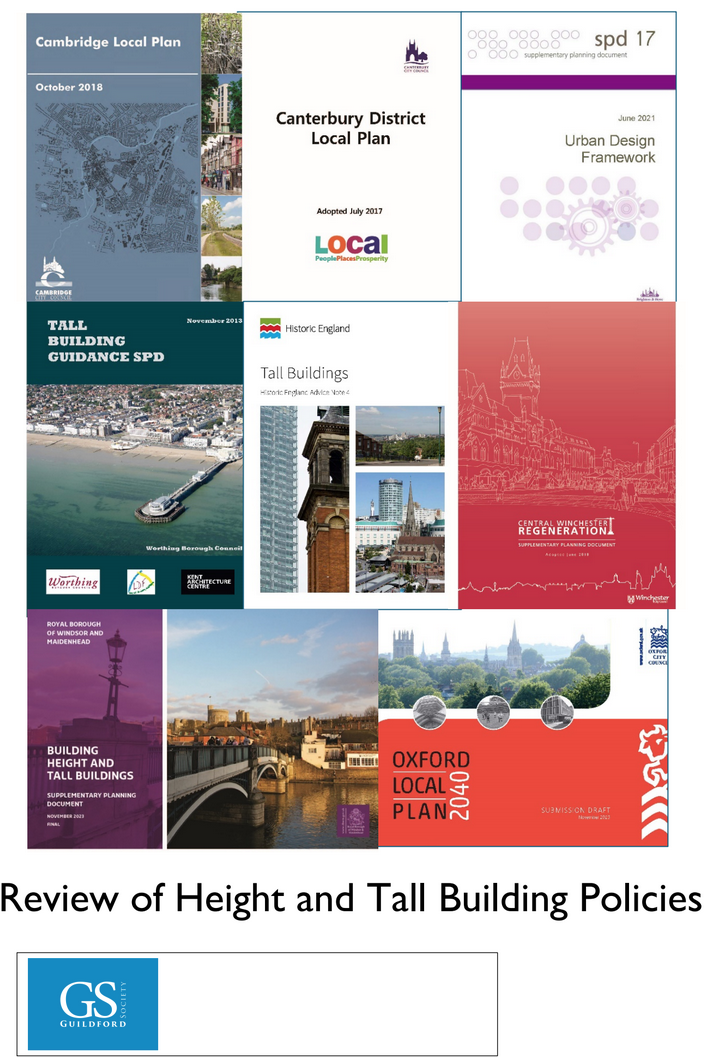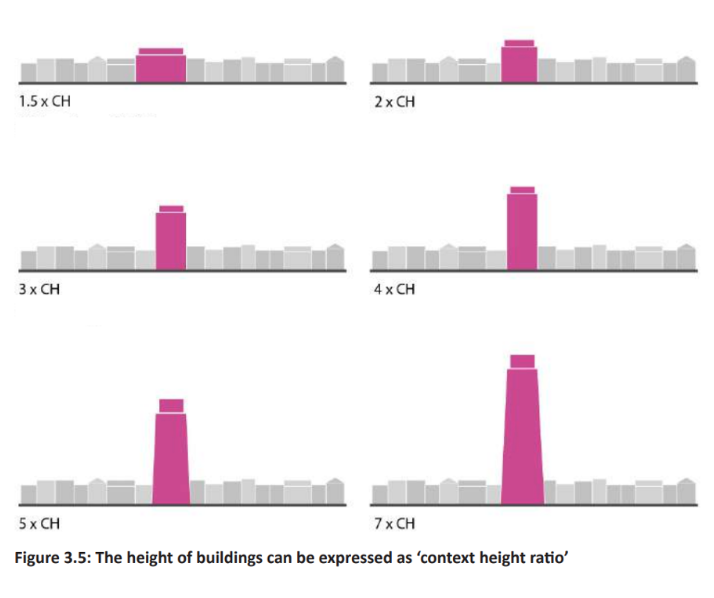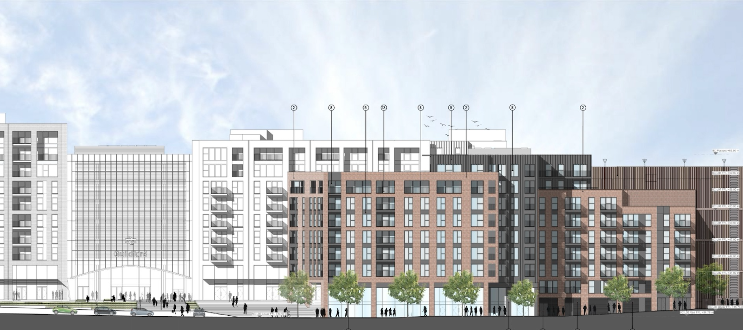 Abraham Lincoln
If given the truth, the people can be depended upon to meet any national crisis...
Abraham Lincoln
If given the truth, the people can be depended upon to meet any national crisis...
 Guildford news...
for Guildford people, brought to you by Guildford reporters - Guildford's own news service
Guildford news...
for Guildford people, brought to you by Guildford reporters - Guildford's own news service
Opinion: Action on Building Heights Is Needed Now
Published on: 2 May, 2024
Updated on: 3 May, 2024
retired architect and member of the Guildford Society
There has been an ongoing discussion about the heights of new developments in Guildford and much concern raised that some major new developments are too high.
This concern has been voiced by councillors from most parties, most local groups such as the Guildford Society and Guildford Residents Association and residents through social media where some worry about the “Wokingisation” of Guildford.
Why should we be concerned, why is this happening in Guildford and what action should be taken to allow greater control of building heights in the future?
Why should we be concerned?
Guildford, like many historic towns and cities in the UK and Europe, has grown organically with most buildings having similar heights which gives a sense of order, understandability and human scale. In Guildford’s case, these are predominantly two and three-storey with a few slightly higher.
Importantly the heights of buildings in these towns and cities are in scale with the streets in which they sit. The streets feel pleasant, and have good amounts of daylight and sunlight because the buildings do not overpower or shadow the streets.

This view of London’s Regent Street shows that architect John Nash conceived the street to have buildings of appropriate height to relate to the street and its width.
Tall buildings of inappropriate height in historic towns and cities risk destroying the orderly scale by attracting attention away from other buildings and streets, breaking and dominating the skyline, competing for attention with historic buildings such as churches and their towers or spires and often blocking important views.
 Unfortunately, many new tall buildings are of poor architectural quality. Many historic towns and cities have varying heights of buildings but higher buildings have often been only proportionally higher than their neighbours.
Unfortunately, many new tall buildings are of poor architectural quality. Many historic towns and cities have varying heights of buildings but higher buildings have often been only proportionally higher than their neighbours.
Tall buildings such as those proposed for St Mary’s Wharf, North Street and Solum, now being constructed at the railway station, are all of unremarkable design quality. This means that because of their height, mass and design they will dominate their neighbours including the many heritage buildings in Guildford.
Why is this happening in our town?
The previous Local Plan failed to control heights adequately as evidenced by the Solum station development. Because of the lack of a formal policy specifically on building heights, a planning inspector gave permission for Solum’s proposal, at appeal, before the 2019 Local Plan was adopted.
Solum is a wall of buildings rising to 10 or 11 storeys which will destroy views across the town and form a visual barrier. Already it can be seen in this photograph that the development, currently under construction, will cut off views (currently still just visible through the steel structure) and devastate the skyline and will also overpower this area of Guildford.
The east elevation of the Solum development below shows the height of this wall of buildings which faces and will overshadow the three-storey Bishops Wharf buildings on Walnut Tree Close.
Despite the issues with Solum, Guildford Borough Council resisted having tight policies in the Local Plan 2019 and associated Development Management Policies. The council has produced and adopted a Guildford Town Centre Views Supplementary Planning Document (SPD) but it has proven inadequate to control heights in the town centre.
Knowing the weakness of the council’s tall building planning controls, developers have been able to ‘game’ the planning system in Guildford. Site values have almost certainly been enhanced on the basis that there is a good chance that developers can obtain approval for high-density, high-building developments. They probably think Guildford is a soft touch.
What action should be taken to allow greater control of building heights in the future?
This is not a new problem and Guildford is not alone in facing the challenges of tall buildings but many other towns and cities now have policies to give them control when they consider tall or larger-scale buildings inappropriate. Guildford Society has researched this and produced a report showing what seven other towns and cities have produced as their tall buildings policies.
 For a copy of our report click here. The report covers policies from Canterbury, Oxford, Cambridge, Brighton and Hove, Winchester, Windsor and Maidenhead and Worthing.
For a copy of our report click here. The report covers policies from Canterbury, Oxford, Cambridge, Brighton and Hove, Winchester, Windsor and Maidenhead and Worthing.
Most of these councils have produced carefully conceived policies that are not simplistically suggesting that all buildings in a town centre must be, say, six storeys or less. They use a number of factors to assess what is defined as a tall building in their town or city and how each development should be considered by their planners.
Most require careful consideration of a proposed new development’s surrounding context. Some use the existing heights of the surrounding area as a baseline against which any new development is considered. So if surrounding buildings are generally x metres or x storeys in height, the “context height”, they accept that new buildings can only be higher by a factor of that context height. The helpful diagram below from Tower Hamlets demonstrates context heights.

The height relationship of a tall building with its context can be expressed as a factor of the prevailing contextual height or as the “context height ratio” (CHR). The CHR indicates the degree of ‘tallness’ of a building in relation to its context. It also provides a measure of the extent to which a building is “outstanding” on the skyline considering the prevailing height and scale of development of a place. The CHR provides a means to discuss the relative relationship of a building’s height within its context and the wider place setting.
Urgency
It is now extremely urgent that action is taken to put in place a policy which will control heights of future development. This cannot wait until the new Local Plan is completed. The obvious solution is to produce a Heights Policy as a Supplementary Planning Document (SPD) or as a Technical Advice Note (TAN).
If GBC does not have the staff resources to produce such a policy in-house, there are consultancies who have the necessary expertise to develop an SPD or TAN working with the planning policy team and wider community.
It should be understood that an SPD or similar, even in draft form, carries weight in considering planning applications as it shows the direction of travel that the council involved is seeking to implement. A SPD or TAN can later be included in the Local Plan.
The production of an SPD or TAN should commence immediately so we are not faced again with the lack of control that has permitted projects like Solum to proceed.
Responses to Opinion: Action on Building Heights Is Needed Now
Leave a Comment Cancel replyPlease see our comments policy. All comments are moderated and may take time to appear.
Recent Articles
- Guildford Institute’s Crowdfunding Project for Accessible Toilet in its New Community and Wellbeing Centre
- Letter: Guildford – Another Opportunity Missed?
- Letter: GBC’s Corporate Strategy – Where Is the Ambition?
- My Memories of John Mayall at a Ground-breaking Gig in Guildford Nearly Six Decades Ago
- Westborough HMO Plans ‘Losing the Heart of the Street’ Says Resident
- College Invests to Boost Surrey’s Economy and Close Digital Skills Gap
- Community Lottery Brings Big Wins for Local Charities
- GBC Housing Plan Promises ‘A Vibrant Urban Neighbourhood’ Near Town Centre
- Hospital Pillows ‘Shortage’ at the Royal Surrey
- Updated: Caravans Set Up Camp at Ash Manor School


Recent Comments
- Ian Macpherson on Updated: Main Guildford to Godalming Road Closed Until August 1
- Sara Tokunaga on GBC Housing Plan Promises ‘A Vibrant Urban Neighbourhood’ Near Town Centre
- Michael Courtnage on Daily Mail Online Reports Guildford Has Highest-paid Council Officer
- Alan Judge on GBC Housing Plan Promises ‘A Vibrant Urban Neighbourhood’ Near Town Centre
- John Perkins on GBC Housing Plan Promises ‘A Vibrant Urban Neighbourhood’ Near Town Centre
- S Collins on GBC Housing Plan Promises ‘A Vibrant Urban Neighbourhood’ Near Town Centre
Search in Site
Media Gallery
Dragon Interview: Local Artist Leaves Her Mark At One of England’s Most Historic Buildings
January 21, 2023 / No Comment / Read MoreDragon Interview: Lib Dem Planning Chair: ‘Current Policy Doesn’t Work for Local People’
January 19, 2023 / No Comment / Read MoreA3 Tunnel in Guildford ‘Necessary’ for New Homes, Says Guildford’s MP
January 10, 2023 / No Comment / Read More‘Madness’ for London Road Scheme to Go Ahead Against ‘Huge Opposition’, Says SCC Leader
January 6, 2023 / No Comment / Read MoreCouncillor’s Son Starts Campaign for More Consultation on North Street Plan
December 30, 2022 / No Comment / Read MoreCounty Council Climbs Down Over London Road Works – Further ‘Engagement’ Period Announced
December 14, 2022 / No Comment / Read MoreDragon Interview: GBC Reaction to the Government’s Expected Decision to Relax Housing Targets
December 7, 2022 / No Comment / Read MoreHow Can Our Town Centre Businesses Recover? Watch the Shop Front Debate
May 18, 2020 / No Comment / Read More













Peter Blow
May 2, 2024 at 12:02 pm
One thing that I don’t think is given enough thought is the wind effect caused by high buildings.
I walk through Leapale Lane/Haydon Place every day. Since Waitrose was built, there has been a tunnel effect created between Waitrose and the telephone exchange that channels the wind, creating a wind tunnel effect.
This is only going to get worse.
Jim Allen
May 2, 2024 at 12:46 pm
An excellently researched piece on building heights. From Burpham only the catherdral can be seen, using Lidar [Light Detection and Ranging] the prominent Guildford Castle mount and the gap in the hills can be dislpayed prominently. Tall buildings are out of place in Guildford, compaired with Woking where the planning inspector has said the damage has been done.
We need that SPD now. Not next week, not next month but now!
Ben Paton
May 2, 2024 at 6:09 pm
Can anyone explain who on the Council for the past 5 years is responsible for the lack of action on this point?
Surely the Lib Dem and R4GV parties for their coalition administration and now the Lib Dems alone since 2023 must take responsibility for doing nothing about it?